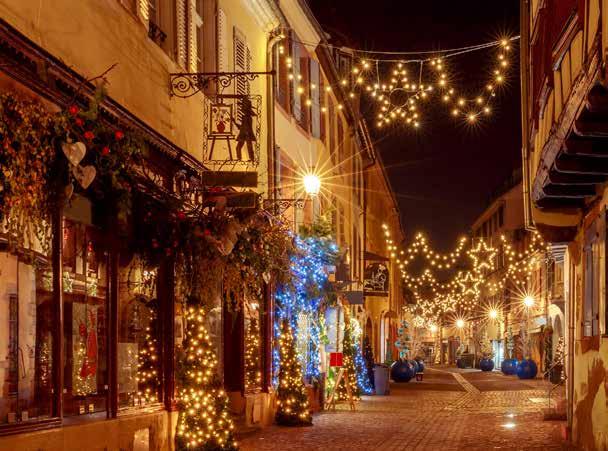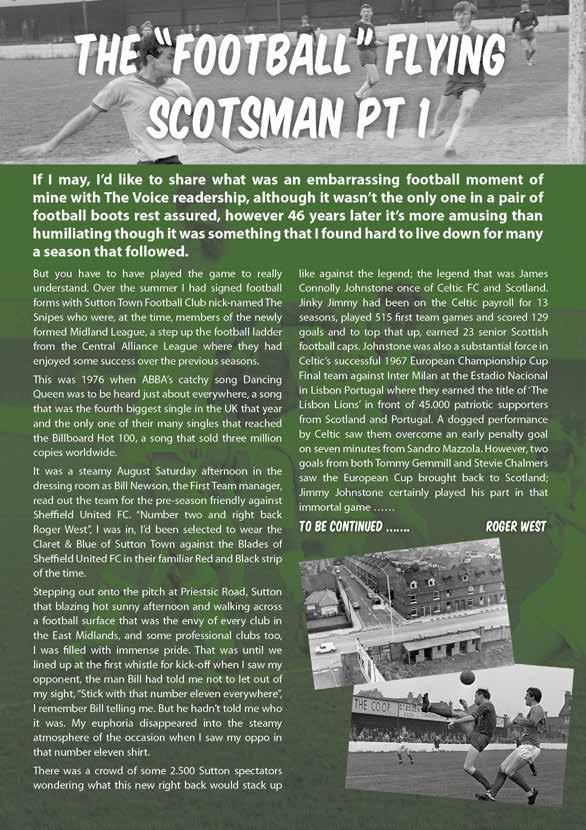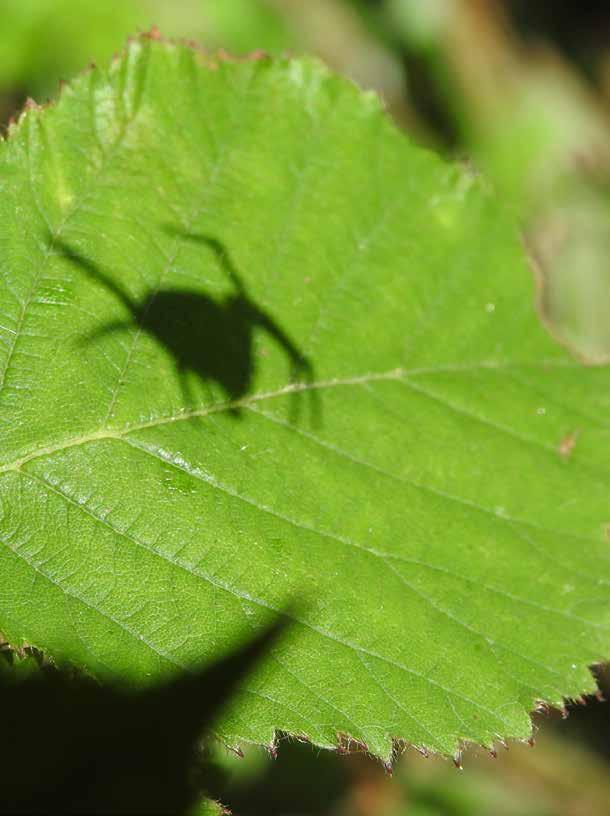

























So, in the interests of my own sanity (and I suspect yours as well), I am going to completely ignore the ‘elephant in the room’ pertaining to Rome burning around us and not mention anything! Please don’t take that as ignorance - I think we all just need to take the light reliefs where we can currently!!!
Here at Voice Magazines, we’ve been on a bit of a roadshow!! When I started this magazine 12yrs ago now, it was all about shopping local and supporting the small local businesses, who very often have far more outgoings than incomings financially speaking, especially in the early days! These businesses don’t have huge budgets, so we wanted to give them a ‘Voice’ to get their message out.
The real threat of losing the high street altogether is more real today than at any other time and whilst some people may see no issue with that, it is a life line for so many people in so many ways from employment to accessibility (not everyone has the internet or the ability to use it) to company (it might be the only people that someone sees that day) to what happens to the properties and much, much more. Personally speaking, I love browsing a high street and finding little hidden gems or impulsive items that you think ‘Ooooo, Caron would love that!’, you can’t do that on the internet!
Apart from all of that, it is local business that keeps local communities and small areas going. The better our high streets, the more the money flows around your area to support the local sports team or donate to
the local charity for example. So, let’s all pull together this year and try and support our high streets – it’s fair to say that they’ve had a rough run over the last few years and now is the time for the community to support them! Bezos doesn’t need to be any richer but the local shopkeepers need to survive this difficult time, so please turn to our high street feature and join the ‘shop local’ revolution.
In other news, as we were out and about this month, you can also read all about our foot scan experience at another grassroots, small, Derbyshire based business who do fantastically on the global footwear platform - Rockfall. I may have mentioned earlier this year about a small plantar injury! Anyway, my crikey, that footscanner machine was amazing, I could see where my arch has fallen, and the physio kept saying about getting a supportive insole but I thought she was probably just being overly cautious! Having tried it, insoles are the future!! Only issue is, I need to make sure that they can be inserted into my *small* shoe collection!! #fingerscrossed
See you next month when who knows what alternative reality we will be in then? Perhaps Santa will start wearing blue!!!
Professional Services pg18 Food & Retail pg24 Pets pg35
Health & Beauty pg36 Home pg38 Garden pg57
As a bona-fide member,
should I say the founder, of T.H.A. (OK, I made it up!) I was really pleased to be asked to contribute an article about National Tree Week which this year runs from 27th November to 5th December.
In a nutshell (acorn cup if you prefer) we NEED trees.
I’m going to chuck in a bit of history now… William the Conqueror took ownership of many of the forests in England, granting hunting rights only to the select few. These woodlands were known as “the Royal Forests” and mere mortals, even land owners, were restricted in their use of forest lands so that the, ahem…”great and good” could “enjoy” a spot of hunting every so often!
Trees nurture and sustain us and the planet we call home in so many ways. From the very air we breathe, to the houses we live in, the furniture we use, and even (some of) the plastic necessary for 21st Century life - trees are essential to our existence.
Without woodlands and forests, land loses integrity and stability. Erosion by wind and water is more extreme without trees acting as wind blocks, and their roots soaking up rainfall. Just look at what happens when forests are cleared in places like the Amazon - biodiversity drops, the soil dries out, there is less rainfall (the Amazon rainforest actually create their own rainfall - did you know that?) and the result is often wildfires.
Trees also soak up carbon dioxide in the atmosphere, and when present in towns and cities it has been estimated that they can reduce urban temperatures by up to 7°C. So, not only do trees slow global warming by capturing and containing CO², they also help keep our cities cooler in the summer as they lose moisture and their leaves reflect heat (from tarmac and concrete) upwards and away from the ground.
It’s not only we humans that benefit from trees, one mature oak tree (my favourite species) can be home to as many as 500 different kinds of birds, insects, and small animals. Felling a great old oak will not just kill the tree itself, but will deprive hundreds of other living creatures of their home. Even trees that have died in situ continue to provide both habitats and food sources for other creatures.
These rights were not overturned until The Forest Charter, 1217. Eight hundred years later, in 2017, a new Charter for Trees, Woods and People was launched with the following objectives:
• Sustain landscapes rich in wildlife
• Plant for the future
• Celebrate the power of trees to inspire
• Grow forests of opportunity and innovation
• Protect irreplaceable trees and woods
• Plan greener local landscapes

• Recover health, hope and wellbeing with the help of trees
• Make trees accessible to all
• Combat the threats to our habitats
• Strengthen our landscapes with trees
These
What are YOU going to do in National Tree Week to aid these objectives?



We’re particularly fortunate at Voice Magazines to get invited to many different events and places but when we were invited to review a foot scanner at Rock Fall by the Managing Director, we were a little surprised! However, I can report that that it was actually one of the most informative, interesting and unexpectedly fun things we have undertaken as a team.
When we arrived, we were greeted by the Factory Shop Manager, Amanda. We received a lovely warm welcome, which continued when we were handed over to the knowledgeable and highly entertaining Dave, who led the demonstration.


The first part of the presentation was really thought provoking, when asked “Do you suffer from back, hip or knee pain? Everyone one of us answered ‘yes’ to one or all of the above and we were surprised to find out that this could be due to our feet.
We were then each invited to stand on the Activ-Step Foot Scanner machine, which assesses the shape, movement and pressure of your specific feet, to be able to identify the pronation and supination of your feet whilst moving.

The foot scanner is so clever and it truly is revealing to identify what kind of foot support you need to alleviate some of these issues. Once you have completed your assessment, you are pointed to 1 of the 3 insoles which best suit your particular feet and when you test the samples, you can really feel the difference in foot support.

This particular technology was originally identified as specifically relevant for tradespeople and people who spend all day on their feet, but the reality is that there is no-one that this isn’t relevant to, who currently, or has in the past, suffered from any back, hip or knee pain. And the best news is, currently Rock Fall have an offer on the insoles, which currently rrp at £32, but you can have the assessment and purchase these insoles for £25 when you purchase a new pair of shoes.
Team Voice can unanimously endorse this gem of a shop on the industrial estate in Somercotes. They provide such a warm welcome, have a great range of products and are highly knowledgeable about such an important subject that few people probably have any experience of. So, if you have any issues with your back, hips or knees – support a local business and help improve your walk – you won’t be disappointed.

















































Black Friday, which is November 25th this year, is one of those American imports I question that we really need. Originally coined to mark the Friday after Thanksgiving when traditionally Americans would start their Christmas shopping.

I delved into the history behind the phrase “Black Friday”, and discovered that the first reference in relation to Thanksgiving was in the early 50s when it related to workers calling in sick the day after the celebrations. Around the same time, the terms “Black Friday” and “Black Saturday” came to be used by the police in Philadelphi to describe the crowds and traffic congestion accompanying the start of the Christmas shopping season.
It took a while for the phrase to gain traction, and it only really became a kind of sales vehicle when an alternative derivation of the meaning was suggested in the 80s. This was that retailers traditionally operated at a financial loss January to November and made their profit during the holiday season, beginning on the day after Thanksgiving. In pre computer accounting days it was usual to use red ink to show negative amounts and black to show positive. Black Friday, under this theory, is the beginning of the period when retailers would no longer be “in the red”.
Many large retailers now try to con us Brits out of our hard earned money by promoting “Black Friday Offers”, and it can be quite tempting to spend cash on what look like great deals…but before you part with your dosh, just check to see if the saving is as great as it claims to be!
Even better, ignore the big retailers altogether during the festive shopping period. Instead concentrate on the high streets of our local towns and villages and spend your money with independent small shops, producers, and makers. They are owned and run by people like you and I who are aiming to make a living for themselves and their families. The money we spend in their shops will not go towards funding the pension of a multi-millionaire at the top of a large faceless corporation.
If you’re not a fan of retail therapy and prefer online shopping, look on the likes of Etsy, Not on the High Street, and even Facebook and Instagram for small shops, creatives, and makers. Many local creators will only be selling online or at local craft fairs and events.
We need to support the people in our local economies. We need to prioritise purchasing from independents, be that in a shop or online. Yes, a multinational may appear cheaper, and with the current state of many of our wallets that is appealing, but big corporations seldom help small towns and villages.
Here’s a challenge for you…keep your pre festive spending in your local area. Buy sustainable products. Limit your purchase of plastic toys in favour of books. And if in doubt, buy a gift voucher from a local shop!







5-8yearsoldand9-14yearsold


It’s Christmas! And we want you to help us spread the festive cheer by joining us at Markeaton Park for the Derby Santa Run! With a BRAND NEW 5K route, the Derby Santa Run is perfect for all ages. Whether you hop, skip, dance or run the route, “yule” be sure to have lots of festive fun. We’re also inviting Santa Paws to get involved, and they can wear their own special ‘pawsome’ festive bandana! Join us at Markeaton Park on Sunday 11 December, run with hundreds of Santas and help spread the Christmas cheer! As a thank you, you’ll receive your very own Santa suit as well as a festival medal and goody bag as you finish.










































One of the most personal items in our collection is a wooden clothes horse made by Paul’s grandad in the 1930’s. Until recently, it was held together by a stocking made by Brettles of Belper which unfortunately disintegrated and fell off. It is now held together with a piece of twine. This simple item of treasured family history is still used in our house today.

Whenever we bring the clothes horse out to show people during our “All Around the Shire” sessions, many people remember it not just for drying laundry, but when placed on its side and covered with a blanket, as a child’s tent. It is generally agreed that you have not had a proper childhood until you have played in a clothes horse tent.
Last week a 96 year old woman came up to me after our session and said that in Yorkshire, it was called a “Winter Hedge”. This was because for the rest of the year, clothes were dried on hedges outside and it was only in the winter that the “Winter Hedge” was used indoors.
When my parents were first married, mum would dry clothes on washing lines strung on hooks high above the picture rail. My dad, being very tall, would complain about being hit in the face by wet nappies as he walked into the room.
As time went on, they had a ceiling rack with a pulley system, sometimes called a “Sheila Maid” What an invention. Dad was able to walk about without a stoop.
Precious memories.

































Looking now at the array of toys and gadgets available for the current generation of children

I often think back to how we, the 1950’s generation, fared in the days of post-war austerity and hardship. How did we survive without the need to have parents build our toys or invest a fortune in batteries.
Simply put, we counted ourselves fortunate to have one main present, perhaps an apple and orange or even some nuts. Chocolate if you were lucky and if you were unlucky, a box of dates in those funny sorts of oval shaped boxes! You always hoped Santa might drop in and obviously he did because the glass of sherry and the mince pies left for him were always gone by Christmas Morning! How Rudolph and the other reindeer ate all those carrots and still managed to deliver all those presents on time is a minor mystery, none of this leaving stuff behind the wheely bin and running off like we see with deliveries today.

Well, we had Bayko building sets and of course Meccano, along with Dinky toys all of which originated in the 1930s. 1953 brought the advent of Matchbox toys produced by Lesney products and available for 1s-6d. A box of paints was always welcome or toy soldiers and of course, dolls were ever popular for the girls, as was a dolls house if you were really lucky.

Play Doh arrived on the scene in 1956, hard to believe it was originally marketed as a cleaning product before becoming so popular as a toy and indeed still around to this day.
Hula Hoops became popular in 1958 and in 1959, Barbie dolls appeared on the market and they also remain popular to this day. An Annual, be it Dandy, Beano or any other, was always welcomed.

Certainly, at our house Christmas always involved making some of our own decorations with paper chains being a popular choice. There were of course paper bells and concertina type garlands you could buy along with the glass Christmas Tree baubles and many other things. The 1950s was not an easy time for many but perhaps life was rather more simple then and we just got on with it.

MANDY’S TRAVEL PAGE

Hi I’m Mandy your Personal Travel Counsellor.
This year has been such a whirlwind that it’s hard to believe that the festivities have circled round again. So this got me thinking, last year my unusual experience gifts received such great feedback that I thought I might send you a few more this year, just to help Santa out! If you want to get organised this year, send me a message, I’d be happy to help.
American Classics Driving Experience for One (Lincolnshire, Northamptonshire, Warwickshire, North Yorkshire)

From £114.00 per person
Take on three of America’s most legendary classic racers – the sleek Corvette, roaring Mustang, and the powerful Camaro SS – for three miles each and discover just why these cars have earned a place in the motoring hall of fame!
Bombay Sapphire Distillery Discovery Experience with Gin Cocktail for Two (Whitchurch, Hampshire)

From £33.00



If you’re partial to a cheeky G&T, you’ll love this Bombay Sapphire Distillery Discovery Experience for two people. Embark on a gin-tastic journey of discovery, learning all about how this popular brand of gin is made in Hampshire. Start the tour with a refreshing Bombay Sapphire gin cocktail before you see what goes into making your favourite tipple.
Visit to Kew Gardens and Palace for Two (Richmond upon Thames)

From £35.00
A World Heritage Site and a top UK attraction, Kew Gardens is the world’s most famous garden. This experience for two is truly wonderful and will make you feel like you’ve stepped into a completely different world – you’ll also learn about the 250 years of science and history behind this world-famous attraction too!
20 Minute Truck Driving Experience for One (Leicestershire, Lincolnshire, Warwickshire and nationwide)

From £47.00 per person
For those who have dreamed of driving a truck, this 20-minute experience could be just the ticket!
Enjoy the opportunity to take control of a mighty race car transporter, measuring an incredible 45 foot – that’ll be tricky around those tight bends! Following an in-cab briefing, get ready to steer this monster around a specially designed track and enjoy plenty of tricky challenges that will test your truck driving skills to the max!
Liverpool FC Anfield Stadium Tour and Museum Entry for One Adult

From £22.00 per person
Liverpool FC’s stadium tour is bigger and better than ever. Experience the magic of an interactive tour behind the scenes at Anfield, one of the most iconic and historic stadiums in the world. Visit the state-of-the-art home team dressing room, the away team dressing room and take the chance to test your interview technique in the press room before you take a spine-tingling walk down the players’ tunnel to the sound of the Anfield roar. *Other football team experiences and locations available – as well as other sports such as Rugby & Cricket*




If you just don’t know what to give the people in your life, why not give them a travel gift voucher.
MANDY OLDKNOW T: 01773 318 540 mandy.oldknow@travelcounsellors.com www.travelcounsellors.co.uk/mandy.oldknow
Don’t forget to mention Voice Magazines when responding to
Ads








1. Spray a large non-stick saucepan with low-calorie cooking spray and put over a medium heat. Add the garlic, shallot, leek, carrot, celery and fennel seeds and fry for 10 minutes, adding a little water if anything sticks.

2. Meanwhile, cook the sausages according to the pack instructions and cut each one into 6 pieces.
3. Stir the rice and stock cubes into the veg. Add 700ml boiling water a little at a time – letting the rice absorb each addition
The italian style sausgaes in this dish are the perfect ingredient and add extra flavour as well as leaving you feeling well fed!
before you add more – and cook for 20 minutes, stirring often.
4. Add the sausages and keep cooking and stirring until the liquid has been absorbed and the rice is cooked to your liking (you might need more water). Remove from the heat and stir in the quark, then scatter over the herbs and season to taste. Serve with salad.
Low-calorie cooking spray
1 garlic clove, finely chopped
1 shallot, finely chopped
1 small leek, finely chopped
1 medium carrot, finely chopped 1 celery stick, finely chopped
½ tsp fennel seeds, lightly crushed
6 Slimming World Italian-style Sausages

200g dried arborio rice
2 chicken stock cubes, crumbled
3 tbsp plain quark



Chopped fresh chives or parsley, to serve
per serving:

LYTHAM ST ANNES




3rd


3rd


Rafa is back!! This walk is nearly as old as he is, having first featured back in September 2013! But like Rafa not too much has changed, except maybe he took it a little slower this time. There are some fantastic views on this walk of Bolsover Castle and Sutton Scarsdale Hall and it’s great for the dogs, with plenty of opportunity to go off lead. However, please be careful, especially if your dogs have a high prey drive, as there are phesants in the woods and sheep protected by electric fences.

A moderate walk for you and your dog with some gradualy climbs. This walk should take 2 to 21/2 hours. There are some sections which cross fields, which may be particularly muddy if it has been wet. There is also a section of road to walk along so please take care and make sure you wear appropriate footwear for the conditions. And as always, follow the countryside code!

1. To begin go through the gate opposite the car park entrance. Continue along the path with a metal fence on your left. Keep to the main path to pass a sculpture on the left.
2. Continue to cross a lane and continue along the trail. Then after a short distance pass under a bridge. After some distance you arrive at a crossroads of footpaths.



3. Turn right and pass through a width restrictor and along the path before crossing over a footbridge. In front of you is a large pond. Go diagonally left

and then skirt around the left-hand edge of the pond. On the opposite side of the pond you will find a marker post and a stile.
4. Cross over the stile and head diagonally left across the field, heading towards ‘Sutton Scarsdale Hall’ on the horizon. After passing underneath a telegraph wire, continue to keep left of some old stone buildings in the field. At the far edge of the field, turn left along a farm track keeping a fence and the motorway on your right. Continue until you reach a road.

5. At the road turn right and go over the motorway. Follow the road round to the left and uphill *At this point, If you wish to take a closer look at Sutton Scarsdale Hall, take the path on the right, half way up the hill*
6. Continue along the road into ‘Sutton Scarsdale’. After the road bends sharp right you will see a footpath to the left sign posted for Heath Village. Take the footpath heading downhill across a field.


7. At the bottom right-hand corner of the field, cross a footbridge and then over a stile into another field. In this field, head straight uphill. At the far end, cross over a stile adjacent to a telegraph pole and onto a lane.
8. Cross straight over the lane through a gate and into another field. Keeping the hedge on your right, go to the bottom of the field to cross another stile.
9. Now you have the hedge on your right and trees on your left. Continue straight ahead to cross another stile onto a lane. Cross over the lane diagonally right, ensuring that in the next field you have the hedge on your left. With the hedge on your left and going gently downhill, go to the bottom left-hand corner of this field.
10. Go through a gap in the fence and cross a footbridge. Go straight ahead, passing through a gap in the boundary of the field, then, at a marker post, turn left. Continue along the edge of the


field, then immediately after a pylon on your left, turn left down a farm track.
11. Continue ahead, keeping the hedge on your right. The path curves left and then right, through a gap into another field and continues downhill with the hedge on the right. When the hedge on the right ends, continue straight towards the motorway crossing an open field.
12. Go over a stile to cross another field, at the far edge of this field turn left keeping the fence on the right. Upon reaching a lane turn right to pass under the motorway.
13. Continue straight to cross an open field heading for a gap in the hedge. After passing through the gap turn left keeping the hedge on your left. Follow the hedge around to the right and after a short distance, go over a stile on your left. Then go over a footbridge and over a second stile into a field.
14. Cross the field diagonally right, keeping Bolsover Castle straight ahead. In the far right-hand corner of the field turn right to cross over a footbridge. Now go diagonally left across a field and then over a stile into a wooded area. After a short distance, go over another stile and into a field.
15. Go diagonally left across the field and then over a stile onto a well laid path (The Stockley Trail). Turn left along the trail, which you can follow, over a road and back to the car park.

This walk is for illustrative purposes only. Voice Magazines Ltd takes no responsibility for anyone who chooses to follow this route and encourages all walkers to obey all byelaws and signs and to respect the area they are walking in, ensuring they pick up all dog mess and obey the countryside code at all times.



People are often curious about how Fairtrade pricing works and how farmers benefit. It’s not rocket science, we promise, and chocolate is one of the most straightforward ways to demonstrate this.
Chocolate is one of life’s simple pleasures. A pleasure many of us enjoy every day. But sadly, the cocoa industry has been blighted by persistent problems like discrimination, exploitation, deforestation, and low prices which perpetuate poverty for the farmers who grow the cocoa. Imagine you buy a £1 bar of non-Fairtrade chocolate. Of that £1, just six pence goes to the cocoa producer. So, who did you just give 94p to? About 40p went to the chocolate company, 35p to the retailer and the rest to other parts of the supply chain.
When terms of trade don’t work for farmers, it is impossible for them to escape from the cycle of poverty. Seen like this, it’s obvious that giving farmers and workers a better deal is not about asking you to pay a higher price. It’s about giving ensuring more of the money gets to farmers.
The Fairtrade minimum price defines the lowest possible price that a buyer of Fairtrade products must pay the producer. The minimum price is set based on a consultative process with Fairtrade farmers, workers and traders and guarantees that producer groups receive a price which covers what

it costs them to grow their crop. When the market price is higher than the Fairtrade minimum price, the trader must pay the market price.


The Fairtrade Premium is an extra sum of money farmers and workers receive for the sale of their goods that they can invest in projects of their choice, such as new health centres or schools. In 2021, sales of Fairtrade products in the UK generated £25.2 million (€30m) for farmers and workers to invest in their businesses and communities.
The unfair status quo of trade isn’t working. With the increasing problems farmers face due to climate change and the cost of living, it is only going to get worse. It’s time for radical change. To make a difference, you can start by choosing Fairtrade.

















The emergence from the pandemic has been strange and at the same time concerning in many areas and Sport was no different. However, after a season re- adjusting, we are looking forward to getting back to normal as last year was a strange one in sport.
Normally if you are good enough the season finishes with a cup final of some sort. Valley’s first team created that opportunity getting into the NLD plate final but, in what was a strange turn of events and for reasons only known to those organising the event, it was designated to be held as the opening event of this season.
Sitting waiting for 2 months would not normally be a good thing but the interest it created within the club with new players joining the men’s, women’s and junior sections was fantastic. The competition it created within the team was brilliant with over 35 players training at any one session and as such Valley went into it confident of success. That being said sport has a strange way of pulling the rug from underneath you and after a valiant effort which left players battered and bruised, we came up short. Hopefully the memory will serve them well and they are in a position to change the outcome at the end of this season.
At the same time the women, with a full season of league fixtures ahead, have had a positive start with 5 new players joining them and with 2 preseason fixtures under their belt and have shown their ability to play some extremely good rugby with their latest win.

The mini / junior section also has an exciting season planned with 12 fixtures and 2 tournaments to play in. If you fancy joining in and
playing the game in a family environment, then we are always on the lookout for new players. We are lucky enough and very proud of the fact that we can count ex England and current Leicester Tigers development coaches amongst those who pass on their skills and experience to players in the club so you can be assured of a great experience no matter what your age or experience you have.
As well as a full season of rugby there will be various things that you can come and enjoy throughout the season from music festivals to family fun days, New years eve parties to bonfire night and not to mention watching the men or women play rugby on a Saturday or Sunday afternoon.
Sunday mornings from at 10am are where we start the journey from the ages of 4 through to 16.
Men train on Mondays and Wednesdays from - 6.45 to 8.30.
Women train on Monday and Thursdays from - 6.45 to 8.30
We all know that things are tight for many of us at the moment, but we think that we offer a great package that starts from £10 per month for the kids subscriptions which includes all the training, food after the session and kit to train in.
If you have any questions then please feel free to call and we will happily discuss this with you.
More than just a club, we are the #ValleyFamily. You can call us on 07595 520 537, visit our Facebook, Instagram pages or website www.ambervalleyrufc.co.uk
Lower






































What makes any business stand out from the rest? The answer can be as simple as the level of care and service offered to its customers and the broader community.

FAMILY-RUN, independent and local, FlameCare certainly ticks all the boxes in terms of ‘going over and beyond’ the call of duty. In terms of local charities, the commitment is as strong and wholehearted as ever. For instance, for any new customer signing up to a central heating maintenance plan, FlameCare is donating the first month’s subscription to Ashgate Hospice. FlameCare is also sponsoring Marcella Kirk, owner of Maison Mes Amis restaurant on Chatsworth Road, on a gruelling desert challenge. Marcella, and her friend, Helen Tait Wright, will be faced with

2,200km of extreme off-roading in their 4x4 Land Rover ‘Precilla’. The challenge entails travelling 2,200km across Morocco through all-terrain, desert, mountains, and ocean. The charitable and warmhearted approach, which is synonymous with FlameCare, is also, of course, extended to its loyal customer base. “Our customers really deserve our support during these challenging times of everincreasing energy bills,” said Managing Director, Simon Fletcher. “That’s why we’ve initiated a price freeze on our central heating and maintenance plans for the next 12 months – starting immediately –from 1st September. This applies to both existing and new customers.” FlameCare’s diversification into bathrooms and bathroom adaptations has been an overwhelming success. Indeed, fitting dates before Christmas are running out fast, so booking early is essential for installations wanted prior to the festive season.
“I contacted FlameCare regarding a bathroom adaptation at my dad’s house, as he was starting to feel unsafe.
From initial visit to final completion, the professionalism from FlameCare shone through every step of the way. The communication and project management were excellent throughout. Every member of staff was sincere, honest, and full of integrity.
The new walk-in shower with grab rails and water-proof boarding has given my dad confidence and me complete peace of mind. I would wholeheartedly recommend” Shaun Bennett
FLAMECARE ARE PROUD TO SUPPORT ASHGATE HOSPICE
From its establishment after the 1914 – 1918 war, the Earl Haig Fund acquired its poppies from England. 1921: MADAME GUÉRIN. It all started with Madame Guérin’s ‘Inter-Allied Poppy Day’ idea. After taking her idea to Field Marshal Douglas Haig and the British Legion, Madame Guérin’s poppies (made by the widows and orphans/women and children of the devastated areas of France) were distributed on British streets on 11 November 1921 – on the country’s first Poppy Day. Madame Guérin personally paid for the British consignment because the Legion was so poor and was reimbursed after the Armistice Day distribution. www.poppyladymadameguerin.wordpress.com/ remembrance-poppy-timeline-for-great-britain/
In 1926, Countess Haig, the wife of Field Marshal Haig, suggested that a factory, employing those men disabled by war, should be started to make poppies for Scotland.
The suggestion was taken up by Earl Haig’s “Appeal Organisation” and premises, in the form of an old wood-chopping factory in the grounds of Whiteford House, were acquired.

From its early origins in March 1926, of “two workers, a pair of scissors and a piece of paper”,

numbers soon rose to twenty-eight by which time, the bulk of the poppies required for Scotland had been made. And there was a waiting list of 117 men who wished to be employed by the factory. A committee of management under the chairmanship of Colonel William Robertson VC came into being and the project began to expand. The collecting tin had been allocated to the British Legion’s Earl Shilton branch, Leicestershire and tins were duly stamped accordingly. Along with Anna Guerin’s French-made poppies they were distributed on the Leicestershire streets – the very first Poppy Day in the UK.
During the run up to the end of the decade, the demand for poppies and wreaths was met while, in 1928, the introduction of “stuffed toys and jigsaw puzzles” heralded an expansion of activity into a wide range of hand-crafted goods.
Wreaths were made with locally grown laurel leaves, wax poppy seeds and moss which were gathered by Girl Guides.
Tins such as these are now incredibly rare to find. Made from old tins – quite often paint ones- by the John Fever Iron Works in London. The company no longer exists and ceased trading in 1969.

Please get in touch if you have anything you would like to share about these fascinating gifts. Contact Richard Godley on T: 07854 646 742 E: eastpeakcic@gmail.com























Across
7 Kidney stuff is hard to learn (5)

11 Thing is, it’s
of a
partner (5)
13 A mark taken as effect of actions (5)
16 Chine set up in alcove (5)
2 Vase produced in blast-furnace (3)
4 Greeting, if included, is a
system (2-2)

10 It’s an approach to earn, roughly (4)






12 Disgusting? Bit of a blast! (4)
15 Strung out axis (shorter for a cab) (4)
17 Bit of barbecue sauce for the potter, please? (3)

I think he might be having us on you know
Mike is always glad to hear from you at : mike.musings@outlook.com
Whilst I’ve no objections to my grandsons cheerily calling me Grumps, it is a bit of a misnomer. As my wife can testify, I’ve always been a happy-go-lucky and philosophical kind of a guy, who never lets things get on top of him and who has consistently smiled through every crisis or challenge during our many years together.
NB – whilst typing that paragraph, I’ve had the fingers of both hands very tightly crossed behind my back. It’s not easy hitting the correct keys with your nose. Took me nearly an hour!
There are however, some things in the modern world that are guaranteed to wind me up. They’re mostly little things like not being offered a knife & fork at a McDonald’s restaurant or the fact that, according to much of the media, football in this country only began in 1992. I accept that in the grand scheme of things, these are relatively minor grumbles. However, don’t get me started on poor use of English.
I’m not talking about basic punctuation errors like misplaced apostrophes etc. Examples include the café offering Tea’s, Coffee’s & Snack’s or the classic notice outside school, Parent’s – please dont park on the yellow line’s.
No, I’m more concerned about the use of language which is either irrelevant, superfluous or just plain nonsense.
How many times have you heard (or perhaps used yourself) the phrase, ‘I just can’t wait for..... etc.’ Of course we all know what it means. The person uttering those words is clearly excited, and eagerly looking forward to something. However, if they can’t wait, just what are they going to do? Top themselves?
What about the athlete suggesting that they’re going to put 110% effort into whatever event they’re taking part in. Surely a more realistic 100% would be sufficient.
When a politician (or just Joe Bloggs on the street) is asked a question and they begin the reply with ‘At this moment in time....’ why not simply say ‘Now’, or if they want a sense of urgency, ‘Right now’?

The word ‘literally’ is used so freely that it is beginning to lose its meaning. Here’s a few examples:-
“He puts in good crosses from the left. He literally doesn’t have a right foot.”
“It was so cold, I literally froze to death!”
“Usain Bolt was so quick out of the blocks, he literally left the rest of the field for dead.”
Text and email use doesn’t help of course with acronyms like BTW, LMK, ROFL, TBH and made up abbreviations like Gr8, G2G & Tnit etc., now widely used in prose.
Language evolves - I accept that – but every time I see, in whatever print format, ‘could of’, ‘would of’, ‘should of’, ‘gotten’ or ‘utilise’ when ‘use’ is more than adequate, I sigh inwardly and just think standards have dropped so far that ‘Pa’ Good, my old English teacher, would have self-combusted had he been teaching today.
Well, if nothing else, having typed this, I suddenly feel a whole lot better – just in time for my ‘copy’ for the Pre-Christmas edition of your Voice Magazine!!









































A piece of advice often given to creative writers is to write about what you know. Which is exactly what journalist Robert Peston, has done in his novel
The Whistleblower



.
Mr Peston is probably best known for his scoop that Northern Rock and RBS went with begging bowls to the Bank of England at the beginning of the 2008 crash, sparking queues of panicking customers outside the banks. He’s been economics editor for the BBC and had his own weekly politics discussion programme on TV.
So yes, he does know about politics, money and finance - and journalism. Add dodgy dealings at the highest level and the mysterious death of the hero’s sister, a high flying Treasury official and you’ve got a fast paced political thriller which grabs your attention and hangs on.
It’s based in the Blair years which greatly adds to the entertainment value for those who remember the heady early days of Cool Britannia. You’ll probably find yourself thinking, I know who that’s meant to be. And there’s plenty of interesting nuggets about the workings of certain kinds of journalists at the top.

Definitely worth a read.




















Very few British spiders will bite you, and of those which do, most don’t draw blood. With one possible exception, they are not effectively venomous. The exception I write of is the ‘False Widow’, a species spreading since its arrival into southwest England from the Canary Islands back in the 1800s. This can bite and for some people, it does produce a very nasty toxic shock. Other species are perfectly harmless, and even the big ones such as the ‘Cardinal Spider’ (the really big leggy House Spider) is probably more afraid of you than you should be of it. However, it is very large, and those long legs make it look intimidating. The big, fat-bodied ‘Garden Spiders’ which live in circular orb-webs are totally benign, though I recall a local Junior School being closed because parents thought these big spiders were False Widows. This said, I have had False Widows reported from a local allotment garden where someone had suffered a bad reaction to a bite from a big dark-bodied spider in his shed.
However, not everyone likes spiders and yet with autumn creeping in, there is no getting away from them. Once we are into November, then bushes, hedgerows, and even windows are well covered in spiders’ webs of various shapes and sizes. Not all spiders make webs and some such as Wolf Spiders actively run down their prey. However, of those species which are web-makers there are two main types. These are the ‘blanket’ or ‘sheet webs’, and, as mentioned earlier, the orb webs. Sheet webs are constructed by spiders called the ‘Linyphiidae’ and there are 280 British species from tiny ‘Money Spiders’ said to bring good luck if you find one on you. These
spiders hang around under their webs waiting for dinner to just drop in. Some small Linyphids make sheet webs in depressions on the ground, on low vegetation, or on tree bark. Autumn fog or dew highlights these shimmering webs across hedges, herbaceous plants, and on trees or shrubs.



The second big spider group is made up of the ‘orb-web’ spiders, the spider family ‘Araneidae’, and this includes the most common orb (i.e., circular) web builders. These inhabit gardens, hedgerows, fields, and woodlands. They are spiders with eight similar eyes, and eight legs with hairs or spines, and with which incidentally they ‘hear’. The webs are particularly distinctive because they are characteristically constructed to form a framework of non-sticky silk to which the spider adds a final spiral of droplet-covered sticky silk. These webs are natural works of art and engineering and begin with the spider floating a line on air currents to a nearby surface. This first line secured, another dropped from the centre makes ‘Y’ shape, and scaffolding follows. Radii of non-sticky silk are secreted before the final spiral of sticky ‘capture silk’ is in place. These little beasties have specially designed extra claws on each foot to help them manipulate silk whilst they spin and to move across the non-sticky parts of their webs. You often see the big-bodied females with their large spherical abdomens sat at the centre of their web. They are generally much larger than the males. The most handsome of these is the Garden Spider and I used to collect handfuls of these on my way to Junior School where I presented them to our class mistress for the nature table. I’m not sure she was impressed!
Don’t forget to mention Voice Magazines when responding to the Ads

























Terracotta pots are not always winter hardy so if you’re not sure, wrap in bubble wrap to stop them cracking.


Also you don’t want plants in containers sitting in water as it will rot the roots so remove any saucers from under the pots and raise off the ground if possible. You can buy little “feet” to do the job, or bricks, stones or wood will work just as well. Even in winter, containers planted with the likes of winter pansies can dry out. But don’t water if it looks like freezing.
Bubble wrap is also handy for helping to insulate greenhouses.



It’s a good time now for pruning fruit trees such as apples and pears as the trees are less likely to bleed and weaken now the sap has retreated down their trunks. The idea is to take out any damaged branches and cut away those which are crossing and rubbing against each other. Ideally you’re looking for a goblet shape so there is good ventilation in the middle of the tree. Shorten growth from this year by a third and go back to a bud facing the direction you want the branch to grow. But don’t prune cherries or plums –leave them for the summer.
And if you’re tempted in this mood of chopping and lopping, to cut back flowering cherry or forsythia, which suddenly look very leggy around now, be aware that you’ll be removing next year’s blossom branches. They really need to be pruned after flowering...

Clear debris, moss and algae from drives, flagstones and patios. Not only can it become slippery, it also breeds fungus and pests.
















Walking round the allotment site the other day I found the man with the mini-vineyard and his son collecting red Rondo grapes to make a rose wine. He told me that the hot dry weather had resulted in a very good yield of all his varieties of grapes (Regent, Phoenix, Rondo, Solaris) and that he had been measuring the sugar content weekly using a refractometer to gauge when to harvest. He had already harvested the early maturing Solaris variety, got his grandson to crush the grapes by treading them and then pressed them to get the juice which was now fermenting. Locally, Solaris vines are grown commercially by Amber Valley Vineyard near Wessington. It had been a good year as the Solaris grapes had accumulated enough natural sugar to give about 10% alcohol without any need for chaptalisation, the legitimate addition of sugar to raise the levels of alcohol. The Solaris juice was already fermenting. The Rondo grapes he was just harvesting would need some sugar adding before fermentation to bring the alcohol level up to about 11.5%, the desirable alcohol level for a light red, rose or white wine. I tasted a few of the red and white grapes. They were quite sweet and not tart and bunches were being sold at the Saturday vegetable shop. His experience shows that by growing the right varieties of vines it is possible to produce your own grapes for wine in this north-east corner of Derbyshire.
(Bridle

333 871 about



site



availability.














